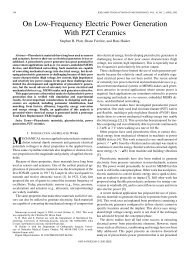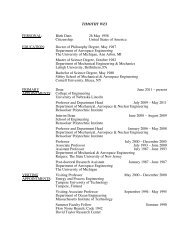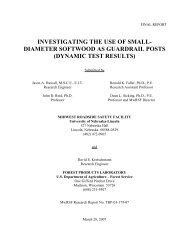Download .pdf of this edition. - College of Engineering - The ...
Download .pdf of this edition. - College of Engineering - The ...
Download .pdf of this edition. - College of Engineering - The ...
You also want an ePaper? Increase the reach of your titles
YUMPU automatically turns print PDFs into web optimized ePapers that Google loves.
University <strong>of</strong> Nebraska-Lincoln<br />
engineering researchers aim to find ways<br />
to make the nation’s bridges last longer<br />
and to design new ones that last a century or<br />
beyond with funding from a new $2 million grant.<br />
With support from <strong>this</strong> four-year grant from the<br />
National Academy <strong>of</strong> Sciences’ Transportation<br />
Research Board, UNL bridge engineering experts<br />
will identify technologies and designs to renovate<br />
existing bridges and develop guidelines for<br />
designing longer-lasting new bridges. It’s part <strong>of</strong><br />
a $150 million congressional initiative to improve<br />
the safety and performance <strong>of</strong> U.S. highways and<br />
bridges.<br />
This research will focus on bridges with spans <strong>of</strong><br />
300 feet or less, which include 95 percent <strong>of</strong> the<br />
nation’s bridges.<br />
Aging bridges are a nationwide concern. <strong>The</strong><br />
Interstate 35 bridge collapse in Minnesota in<br />
August 2007 raised public awareness <strong>of</strong> bridge<br />
conditions nationwide. Roughly 30 percent <strong>of</strong> U.S.<br />
bridges are structurally or functionally deficient,<br />
said Atorod Azizinamini, the civil engineering<br />
pr<strong>of</strong>essor who will lead <strong>this</strong> research. Azizinamini,<br />
an internationally known bridge researcher,<br />
is director <strong>of</strong> UNL’s National Bridge Research<br />
Organization, a division <strong>of</strong> the UNL-based<br />
Nebraska Transportation Center.<br />
While replacing all aging or deficient bridges would<br />
be ideal, the cost is prohibitive. Finding ways to<br />
extend the useful life <strong>of</strong> rehabilitated, replacement<br />
and new bridges using modern materials and<br />
construction techniques and technologies is more<br />
practical, Azizinamini said.<br />
A highway bridge’s typical lifespan is 75 years. This<br />
research aims to extend that service life to 100 years<br />
or more, Azizinamini said. Increasing the service<br />
life could reduce costs significantly. Researchers<br />
also will study improved methods for predicting a<br />
bridge’s lifespan so governments can better plan for<br />
maintenance needs.<br />
UNL civil engineering pr<strong>of</strong>essors Maher<br />
Tadros and Andrzej Nowak, also leading bridge<br />
engineering experts, will collaborate with<br />
Azizinamini on <strong>this</strong> multidisciplinary project<br />
along with international consultants.<br />
<strong>The</strong> project also has an educational component.<br />
Graduate students in civil engineering who assist<br />
with the research will have the opportunity to<br />
work with some <strong>of</strong> the world’s top bridge designers<br />
and researchers, Azizinamini said. <strong>The</strong> UNL team<br />
will also work with international consultants and<br />
researchers from leading design and construction<br />
companies.<br />
Azizinamini said UNL’s longstanding<br />
collaboration with the Nebraska Department<br />
<strong>of</strong> Roads helped position the university to win<br />
<strong>this</strong> project. This strong partnership has led to<br />
innovative road and bridge designs statewide.<br />
<strong>Engineering</strong>@Nebraska 11







